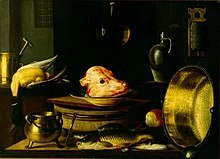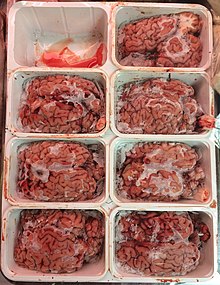

Beef brains and veal (juvenile beef) or calf's brains are used in the cuisines of France; Italy; Spain; El Salvador; Mexico, etc. where they are called sesos in Spanish and are eaten in tacos and quesadillas; Pakistan and Bangladesh also in parts of India like Kolkata and Kerala, where they are known in Urdu and Bengali as Maghaz; Portugal; Egypt, where they are eaten fried and Indonesia.
Calf's brains, or cervelle de veau, is a traditional delicacy in Europe and Morocco. It is the brain of a calf consumed as meat.[1] It is often served with tongue, sauteed with beurre noir and capers, or mixed with scrambled eggs. In Italy, cervella fritte is a popular dish made of bite-sized batter-fried morsels of beef brain.
Outbreaks of bovine spongiform encephalopathy (BSE, commonly known as mad-cow disease) led to legislation to reduce risks of contracting the human variant of the illness by consumption of beef brains and spines.[2][3]
See also
References
- ^ Ward, Artemas (1911). The Grocer's Encyclopedia. New York.
{{cite book}}: CS1 maint: location missing publisher (link) - ^ "The Basics of Mad Cow Disease". WebMD. WebMD LLC. Retrieved 26 June 2018.
- ^ Arthur, Charles (21 March 1996). "The BSE Risk: to eat or not to eat- the facts behind the disease". The Independent. Retrieved 26 June 2018.








